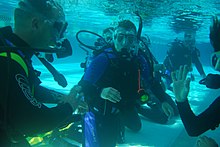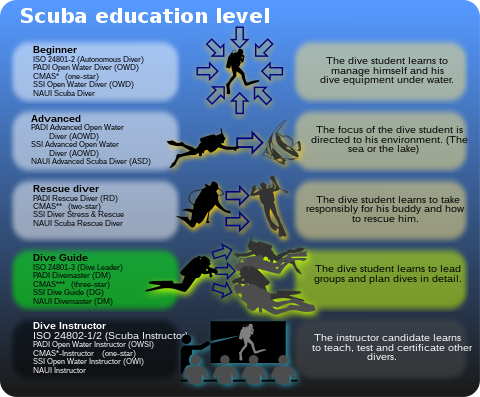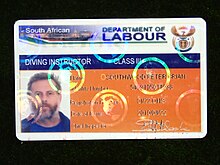


Adiving instructor is a person who trains and usually also assesses competence of underwater divers. This includes freedivers, recreational divers including the subcategory technical divers, and professional divers which includes military, commercial, public safety and scientific divers.
Depending on the jurisdiction, there will generally be specific published codes of practice and guidelines for training, competence and registration of diving instructors, as they have a duty of care to their clients, and operate in an environment with intrinsic hazards which may be unfamiliar to the lay person.[1] Training and assessment will generally follow a diver training standard, and may use a diver training manual as source material.
Recreational diving instructors are usually registered members of one or more recreational diver certification agencies, and are generally registered to train and assess divers against specified certification standards. Military diving instructors are generally members of the armed force for which they train personnel. Commercial diving instructors may be required to register with national government appointed organisations, and comply with specific training and assessment standards,[2] but there may be other requirements in some parts of the world.

A diving instructor trains and assesses the competence of persons who intend to become underwater divers. The instructor may use training standards and materials provided by the certifying organisation, or may develop suitable training standards, depending on the training system and authority involved. Most recreational training and certification agencies provide suitable training materials and require their registered instructors to train and assess using the materials provided.
Commercial diving schools may have a broader scope of options, and may be expected to develop and maintain their own training materials, which may be required to comply with a published training standard.[2][3][4]
The earliest known diving manual was written by the Deane brothers in 1836. This described the use of the Deane helmet, which was not attached to the suit, and was open to the water at the bottom, and would flood if the diver bent over or fell, but could not cause helmet squeeze.[5] Siebe Gorman produced diving manuals in the 19th century. By 1883 the Siebe Gorman manual was available in Spanish: Siebe y Gorman (1883). Manual Del Buzo E Instrucciones Para Operaciones Submarinas. Madrid. pp. 64 pages and 16 plates.{{cite book}}: CS1 maint: location missing publisher (link)[6]
This section needs expansion. You can help by adding to it. (November 2019)
|
This section is empty. You can help by adding to it. (December 2016)
|
In 1953, Jack Atkinson, the first National Diving Officer of the British Sub-Aqua Club, and Colin McLeod started a system of training and accreditation for Third Class, Second Class and First Class Divers, which was based on the three-tier system with which they were familiar, as used for divers in the UK armed forces. This programme was developed over the next six years culminating in the first BSAC Diving Manual, published in 1959. Oscar Gugen, one of BSAC's founders, and George Brookes travelled the UK helping to set up branches of BSAC, all of which used amateur instructors to deliver the BSAC training programme within the club setting.[7]
In 1955, Dottie Frazier became the world's first female scuba diving instructor. Dottie Frazier is also recognized as the first female hard-hat diver, first female instructor and the first female to own and operate her own dive shop.[8] Along with diving, Frazier also worked with the United States Navy to design wet suits and dry suits for military and recreational divers.
In 1959, The YMCA developed the first nationally organised scuba diving course and certified their first skin and scuba diving instructors in the United States.[9][10]
When a scientific diving operation is part of the duties of the diver as an employee, the operation may be considered a professional diving operation subject to regulation as such. In these cases the training and registration may follow the same requirements as for other professional divers, or may include training standards specifically intended for scientific diving. In other cases, where the divers are in full control of their own diving operation, including planning and safety, diving as volunteers, the occupational health and safety regulations may not apply.[2][11]
Where scientific diving is exempt from commercial diving regulation, training requirements may differ considerably, and in some cases basic scientific diver training and certification may not differ much from entry level recreational diver training.
Technological advances have made it possible for scientific divers to accomplish more on a dive, but they have also increased the complexity and the task loading of both the diving equipment and the work done, and consequently require higher levels of training and preparation to safely and effectively use this technology. It is preferable for effective learning and safety that such specialisation training is done systematically and under controlled conditions, rather than on site and on the job. Environmental conditions for training should include exercises in conditions as close as reasonably practicable to field conditions.[12]
This section needs expansion. You can help by adding to it. (December 2016)
|
A diving instructor is as a rule required to be qualified as a diver to at least the same level as the divers to be trained. Additional requirements vary.

Instructors of professional divers are generally required to be qualified as supervisors for the level of diver they can train, and may also be required to have some qualification in adult education as facilitators, assessors or moderators, and to be registered with a governing body. There is usually also a requirement for some experience in the industry before a diver can be trained as a supervisor, and similarly before a supervisor can become an instructor. The actual requirements vary depending on the jurisdiction.
InSouth Africa a commercial diving instructor is registered by the Department of Labour for the class of diving they are considered competent to instruct, and can only instruct learner commercial divers through a commercial diving school, also registered with the Department of Labour.[2][13] The minimum requirement for registration as a commercial diving instructor include registration and practical experience as a Diving Supervisor of the same class and certification or equivalent work experience as a training facilitator in adult education.[14]: 14, 25
For example, the minimum requirement for registration as a Class IV Commercial Scuba Instructor would be:
The total time required is more than 4 years, including training and work experience.
Similar requirements apply to registration as surface supplied and saturation diving instructors. In each case the applicant must first be qualified and have appropriate work experience as a diver, then supervisor in the class of diving before being eligible for application for registration as an instructor for that class of diving.[14]
Recreational diving instructors may be subject to significantly less stringent requirements. These are set by the certification agencies to which they are affiliated, and may also be specifically or generally regulated by health and safety legislation. In the UK the Diving at Work Regulations specifically include training of recreational divers,[3] while in the US and South Africa, the professional diving regulations specifically exclude recreational diving instruction,[2] but in South Africa the work is covered by the general constraints of the Occupational Health and Safety Act, 1993.
Minimum requirements to attend a recreational diving instructor training programme vary between certification agencies. The requirements for PADI Instructor Development Course (IDC) are 6 months as a certified diver, registration as a PADI Divemaster, with 60 logged dives, a medical statement that the applicant does not suffer from a disqualifying medical condition and recent participation in PADI Emergency First Response training. The IDC takes five to seven days, and comprises two parts, Assistant Instructor training and Open Water Scuba Instructor training. During the IDC the candidate will learn PADI Standards and Procedures, The PADI system of instruction, diver safety and risk management, The role of the diving instructor in the recreational diving industry, and marketing and sales counseling for recreational diving business. 100 logged dives are required before the applicant can take the two-day Instructor Examination.[17]
CMAS has a tiered system of instructor qualifications, from 1-star to 3-star. The prerequisites for 1-star instructor are a minimum age of 18 years, a certificate of medical fitness to dive, having held a CMAS 3-star diver certificate for at least a year, basic first aid and CPR certification, and emergency oxygen administration from CMAS or a recognised equivalent. Diving experience must include at least one hundred logged open water dives, including night dives, low visibility dives, deeper dives to depths between forty and fifty-six meters, drift dives, dives in cold water and navigation dives.[18] The candidate must complete all the assessments, which include thorough knowledge of all diving theory and skills prescribed in the diver training standards, confined water skills and teaching them, open water skills, demonstrate competence in all the water skills required for 3-star diver certification at an exemplary level, perform risk assessment for in-water training, teaching and lesson preparation and delivery skills, and emergency procedure skills of diver rescue, rescue management and oxygen administration to the published standards.[18]
ISO publishes standards for recreational diving instructors, specifying minimum required experience and competency of scuba instructors, and relevant requirements for safety practices for recreational scuba diving service providers. ISO 24802-1:2014 Recreational diving services – Requirements for the training of scuba instructors – Part 1: Level 1, and ISO 24802-2:2014 Recreational diving services – Requirements for the training of scuba instructors – Part 2: Level 2 refer to the competence required of a recreational scuba instructor and specify the associated evaluation criteria.[19][20]
A Master Instructor is a certificate given in recognition of a minimum level of experience in training divers after certification as a Diving Instructor, issued by PADI and SSI.[21][22]
PADI requires a minimum level of experience in a range of instruction activities, attendance at three or more instructor development seminars, a record of adherence to the official PADI training systems, support of the PADI organisation, and a quality assurance record which has been clean for at least six months. It is a prerequisite for application for course director.[21]
The SSI rating of Master Instructor is issued in recognition of meeting the required level of experience in training and assessment of recreational scuba divers to SSI standards. No additional training is required. It is a required milestone before application for membership of the SSI Product Review Committee and for admission to an Instructor Trainer program.[23][22]
This section needs expansion with: requirements for technical diving instructors [24]. You can help by adding to it. (January 2024)
|
The diving instructor will generally have a duty of care to the learners in training, as well as contractual obligations, some of which may be specified in the training contract. The scope of this duty of care may be stipulated by statutory law, regulations, codes of practice, training standards, training manuals, terms of registration with a training organisation and employment contracts.
This section needs expansion. You can help by adding to it. (October 2016)
|
This section needs expansion. You can help by adding to it. (July 2020)
|
Professional diving schools generally employ instructors specifically as members of the teaching staff. Recreational instructors may be employed as teaching staff, general staff at a dive shop, with teaching duties, or part-time teaching staff. They may also be self-employed, or train club members on a volunteer basis, for which they may be fully or partly remunerated.
In 1995, a study conducted on Queensland, Australia diving instructors showed that positive job satisfaction correlated with intention to remain in the dive industry and still active in their present job for the next 12 months.[25] The same study also showed that wages were still a primary concern since it was first noted by Kessler in 1976.[25][26]